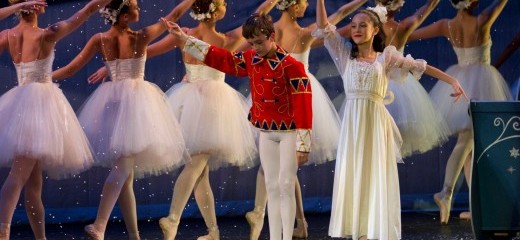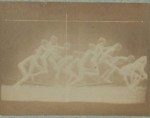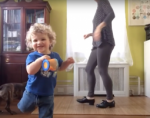
An Annual Nut to Crack
by Lynn Matluck Brooks
When my son was seven or eight years old, he sweetly invited me on a “date.” His invitation was for the Nutcracker performed by the Central Pennsylvania Youth Ballet (CPYB) at the Hershey Theatre. I was so touched. I didn’t have the heart to tell him I’d rather see almost any other dance performance than Nutcracker, so of course we went. It was all so sweet – being with him, in chocolate-scented Hershey, at the town’s faux-Arabian theatre, amid hundreds of other parents and kids in holiday garb watching this super-sweet story-ballet. CPYB trains its students with finesse and although they were students, they did a respectable job. As we walked to our car after the show, my son told me he’d wanted to do something to make me happy so he’d suggested the date. I melted like an overheated Hershey’s Kiss. That date was worth anything – even another student production of the Nutcracker.Fast forward some years, and now I’m a grandma. All three of the sweet children in our family’s newest generation join the ranks of the thousands of other youngsters fed through the maws of the Nutcracker annually. The grandkids take this show very seriously, as does the excellent school the production serves, in large part, to support. The eldest boy, now twelve, rose through the children's ranks to be the Nutcracker Prince this year, in which role he elegantly partnered a Clara taller than he (pictured in their bow, above). Quentin gamely met the challenge: supports, balances, even lifts. His miming was energetic and funny. His younger brother J.T., despite a broken arm from horsing around in the studio after rehearsal, gave a bouncy performance as a Chinese doll, full-arm cast hidden by a colorful sock from hand to shoulder. The little one – four-year-old Natalie – was irresistible in her velveteen dress as she waved at the snowflakes from the sled stage left. So sweet! Isn’t it? Since their mom will produce the family’s fourth baby ballet dancer in a few weeks’ time, I anticipate seeing this very Nutcracker for at least eighteen more years! It marks our seasons: every Sunday after Thanksgiving, we know where we’ll be and what we’ll see. Something to look forward to! Isn’t it?
I love ballet, I teach it, take classes, watch it, and – maybe therefore – if I’m sitting in a theater, I want to see it only at its most breathtaking production levels. Of course, I’m well aware that children must learn ballet before they can reach those performance heights. I do know this, and yet watching children perform – children I don’t know and love like the grandkids, that is – can be painful at worst, boring at times, or—yes—delightful on occasion. Because I see this same production year after year, I recognize some children and can admire the progress of this newly promoted little pointe dancer, or a now-elegant young soloist, or that nicely dramatic corps dancer. But I really don’t need to see these children’s parents waltzing through the party scene, or the now-familiar rented scenery, or hear the recorded music.
That’s the performance side of my ambivalence. There is also the work itself: yes, the very Nutcracker itself.
What kind of scenario informs this odd work? Its two acts seem barely connected. Where is the dramatic pith, the coherence? What’s going on with this narrative? Why should I care? The action unfolds slowly and fails to engage me. At the climax of Act I, Clara actually kills the mouse king—with her slipper! Is this some kind of subtle commentary on the deadly effects of pointe shoes? What about this Kingdom of Sweets in Act II? What message does that send in our increasingly obese society? Why do Clara and her Nutcracker fellow sit around with nothing to do for so long? And these vaguely “character” dances: don’t they epitomize cultural stereotyping?
Roland John Wiley, in his authoritative Tchaikovsky’s Ballets (Oxford, 1985), remarked, “If ever Tchaikovsky wrote an ill-starred work, it was Nutcracker. Had he known what miseries he would endure while writing it he would surely have refused.” Not surprisingly, part of Tchaikovsky’s unhappiness resulted from his lack of enthusiasm for the scenario, forced on him by Vsevolozhsky, director of Russia’s Imperial Theatres. You don’t say no to such an employer. But, inspired Tchaikovsky was not and he even wrote that images from Casse-Noisette, as he called it, “frighten, horrify, and pursue me.”
The great choreographer Petipa, too, found himself in a pickle with this ballet, for he assigned school children to play the leads—setting the precedent for roles that so many students still yearn to fill—and then had to figure out how to choreograph interesting material for them. Shortly after rehearsals began, Petipa withdrew, too ill to continue, leaving the choreography to his talented but historically shadowy assistant, Lev Ivanov, whose thankless job it was to pick up where Petipa had left off and haul the production to its premiere. Wiley speculates whether “Petipa’s indisposition was not in some way linked to his realization that the defects of Nutcracker did not admit of easy remedy.” On top of all this, a contemporary commentator regarded the first Sugar Plum Fairy, Antonietta Dell’Era, as a “heavy, large, unpretty, ungraceful dancer” who slid onto Russia’s stages in a flood of Italian ballerinas – then all the rage. The ballet’s early critical reception was poor.
Yet somehow this lemon has managed to create its own flood of lemonade, funding ballet schools, companies, and theaters throughout the world (and I’m grateful for that gift to our art). What makes it stick? Is it the mind-numbing story? – the memorable, maybe too-memorable, melodies of the score? – the familiar yet malleable choreographic vignettes? – the opportunities it offers to scores of children, teens, and almost first-class dancers in year-after-year performances? I haven’t the answer, but somehow Nutcracker transcends its gossamer of composite parts to become the foundation of ballet as much of the world knows it today.
Onward to the Kingdom of Sweets! Toothbrush, anyone?
By Lynn Matluck Brooks
December 21, 2011










